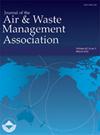Total human exposure: basic concepts, EPA field studies, and future research needs.
IF 2.7
4区 环境科学与生态学
Journal of the Air & Waste Management Association
Pub Date : 1990-07-01
DOI:10.1080/10473289.1990.10466747
引用次数: 62
Abstract
Historically, environmental regulatory programs designed to protect public health have monitored pollutants only in geophysical carrier media (for example, outdoor air, streams, soil). Field studies have identified a gap between the levels observed in geophysical carrier media and the concentrations with which people actually come into contact: their daily exposures. A new approach--Total Human Exposure (THE)--has evolved to fill this gap and provide the critical data needed for accurately assessing public health risk. The THE approach considers a three-dimensional "bubble" around each person and measures the concentrations of all pollutants contacting that bubble, either through the air, food, water, or skin. Two basic THE approaches have emerged: (1) the direct approach using probability samples of populations and measuring pollutant concentrations in the food eaten, air breathed, water drunk, and skin contacted; and (2) the indirect approach using human activity pattern-exposure models to predict population exposure distributions. Using the direct approach, EPA has conducted over 20 field studies for pollutants representing four groups--volatile organic compounds, carbon monoxide, pesticides, and particles--in 15 cities in 12 states. The indirect modeling approach has been applied to several of these pollutants. Additional research is needed in a great variety of areas. Even from the few projects completed thus far, the THE approach has yielded a rich new data base for risk assessments and has provided many surprises about the relative contribution of various pollutant sources to public health risk.人体暴露总量:基本概念、EPA实地研究和未来研究需求。
从历史上看,为保护公众健康而设计的环境监管计划只监测地球物理载体介质中的污染物(例如,室外空气、溪流、土壤)。实地研究已经确定了在地球物理载体介质中观察到的水平与人们实际接触到的浓度之间的差距:他们的日常暴露。一种新的方法——人体暴露总量(THE)——已经发展起来,以填补这一空白,并提供准确评估公共卫生风险所需的关键数据。The方法考虑每个人周围的三维“气泡”,并测量通过空气、食物、水或皮肤接触该气泡的所有污染物的浓度。已经出现了两种基本的方法:(1)直接方法,使用人口的概率样本,测量所吃的食物、呼吸的空气、喝的水和接触的皮肤中的污染物浓度;(2)利用人类活动模式-暴露模型间接预测人群暴露分布。采用直接方法,美国环保署在12个州的15个城市对污染物进行了20多项实地研究,研究对象包括四类污染物——挥发性有机化合物、一氧化碳、杀虫剂和颗粒物。间接建模方法已应用于这些污染物中的几种。需要在许多不同的领域进行进一步的研究。即使从迄今为止完成的少数项目来看,该方法也为风险评估提供了丰富的新数据库,并提供了许多关于各种污染源对公共健康风险的相对贡献的惊喜。
本文章由计算机程序翻译,如有差异,请以英文原文为准。
求助全文
约1分钟内获得全文
求助全文
来源期刊
自引率
3.70%
发文量
0
审稿时长
6 months
期刊介绍:
The Journal of the Air & Waste Management Association (J&AWMA) is one of the oldest continuously published, peer-reviewed, technical environmental journals in the world. First published in 1951 under the name Air Repair, J&AWMA is intended to serve those occupationally involved in air pollution control and waste management through the publication of timely and reliable information.

 求助内容:
求助内容: 应助结果提醒方式:
应助结果提醒方式:


